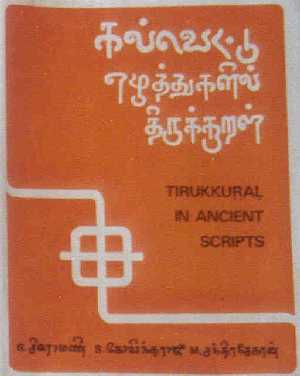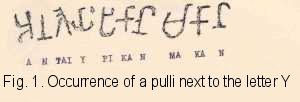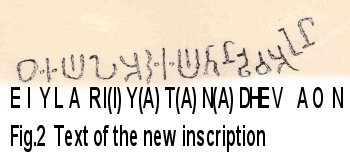

Home | Biodata | Biography | Photo Gallery | Publications | Tributes
Epigraphy

 |

Home | Biodata | Biography | Photo Gallery | Publications | Tributes Epigraphy |
 |
The antiquity of writing in India stretches back to the Indus civilization -- a civilization which lasted for almost a thousand years, from 2500 to 1600 B.C. With the disappearance of the Indus civilization there is a gap of over a thousand years before we come across inscriptions again. These inscriptions belong to the reign of Emperor Asoka in the third century B.C. The most common script used in Asokan inscriptions was Brahmi. In addition, the Kharosthi, Greek and Aramaic scripts were also used. There is reason to believe that Brahmi, unlike the other scripts, was invented in India just before the reign of Asoka. Scholars have traced the development of all the various alphabets in India from the third century B.C. Brahmi in one continuous evolution of multiple forms from the single parent stock.
The earliest Tamil inscriptions are written in a script called Tamil-Brahmi which closely resembles Asokan Brahmi. The Tamil-Brahmi inscriptions were discovered about seventy years ago in the natural caverns on hillocks near Madurai, but only during the sixties were these inscriptions successfully deciphered using the fact that the early inscriptions used a notational system different from that of the Asokan Brahmi. Two other systems of writing have also been used. One system was similar to the Asokan system and the third system was the Tamil Pulli system where a pure consonant was marked by a circular pulli or dot.
Students of Mathematics of the American College, Madurai led by Mr. Jebarajan have been studying the Tamil-Brahmi inscriptions of Madurai region. Some months ago they brought to light the occurrence of a pulli in the Anaimalai inscriptions.("Sunday Standard", February19, 1978)
Recently, while examining inscriptions at Vikramangalam, about 25 km northwest of Madurai, they made two interesting discoveries. First, at the top of a stone bed in the main south-facing cavern, they found a pulli on a known inscription (Fig.1). The inscription refers to "ANTHAIY PIKAN MAKAN". Immediately after the letter Y there is a vertical stroke at the top right hand side. If this pulli can be confirmed as a consonant-marker, then one has to admit that the pulli had been in use from the earliest times. The early occurrence of the pulli in the Tamil-Brahmi inscription would support an early date for "Tholkappiam."
Secondly, they discovered a new inscription (Fig. 2). Adjacent to the main cavern there is another small cavern in which a student lay on his back enjoying the cool breeze. On the ceiling he found a new Brahmi inscription hitherto unnoticed by scholars.
When the student first saw the inscription little did he realize that it was a new Brahmi inscription. On May 18, Mr. Jebarajan and his team took Dr. Siromoney to the spot to examine the inscriptions. Then we compared all the inscriptions with the texts of known inscriptions and the ceiling inscription did not fit in with any of the known inscriptions. Only then did it become clear that the ceiling inscription had not been noticed before.
On the floor we noticed a peculiar symbol made up of a circle and a straight line in the form of the Greek letter phi. This is believed to be one of the basic signs from which many Brahmi letters could have been derived at the time of the invention of the Brahmi script.
The ceiling inscription is about 70 cm long and the height of the letters varies from 5 cm to 10 cm. Normally inscriptions are found on the brow of the cavern and at the top of the stone bed, but not on
the ceiling. A tentative reading of the new inscription is
The word, "Devaon" begins with the symbol which resembles the mirror reflection of the Arabic numeral 5. This symbol is the aspirated D@HE of Asokan Brahmi. This is the first time that this rare character occurs in a Tamil-Brahmi inscription.
It is quite possible that some of the letters may be given alternative readings. For instance, instead of L one may read the fourth letter as LE since there is some evidence of a lower horizontal stroke on the upper left side. The letter 0 in the penultimate position is unusual. One might perhaps read it as KE or KU or KO. The first letter of the inscription may be read as TH instead of E. Whatever be the alternative readings there is no doubt that the inscription refers to a donation and that it belongs to the early second or third century B.C.

